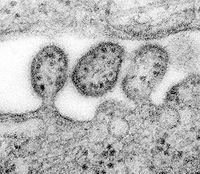Lassa virus
| Lassa virus | ||||||||||||||||||||||
|---|---|---|---|---|---|---|---|---|---|---|---|---|---|---|---|---|---|---|---|---|---|---|

Lassa virus virion |
||||||||||||||||||||||
| Systematics | ||||||||||||||||||||||
|
||||||||||||||||||||||
| Taxonomic characteristics | ||||||||||||||||||||||
|
||||||||||||||||||||||
| Scientific name | ||||||||||||||||||||||
| Lassa mammarenavirus | ||||||||||||||||||||||
| Short name | ||||||||||||||||||||||
| LASV | ||||||||||||||||||||||
| Left | ||||||||||||||||||||||
|
The Lassa virus , (scientifically Lassa mammarenavirus , LSAV ) causative agent of Lassa fever , is a species (type) of enveloped single (-) - stranded RNA - viruses (ss (-) RNA) of the genus from the family Arenaviridae . Like the Lujo virus , it belongs to the old world arenavirus group within this genus. New world arenaviruses such as the causative agents of Junin fever and Machupo fever are somewhat more widely related . They are all assigned to the highest risk group 4 .
As of March 2018, Lassa fever was endemic in the following African countries: Benin, Ghana, Guinea, Liberia, Mali, Nigeria, Sierra Leone and Togo. Infections have also been reported in Central African Republic, Senegal, and other African countries.
discovery
In 1969, missionary nurse Laura Wine fell ill with a mysterious illness that she suffered from an obstetrician patient in Lassa, a village in Borno state , Nigeria. She was then taken to the Nigerian city of Jos , where she died. Two other people were subsequently infected, including fifty-two-year-old nurse Lily Pinneo, who had taken care of Laura Wine. Samples from Pinneo were sent to Yale University in New Haven , where a new virus, now known as Lassa mammarenavirus , was isolated for the first time. In 1972 it was found that the natal multi- teat mouse Mastomys natalensis is the main reservoir of the virus in West Africa and, as a vector, can excrete the virus in urine and stool without showing any visible symptoms.
Systematics
For the following three subtypes, data on the genome sequence were stored in sequence databases:
- Isolat LP - Prototy from northeast Nigeria (with the village of Lassa) ('Lineage I')
- Isolate 803213 - from South Nigeria ('Lineage II')
- Isolate GA391 - from Central Nigeria ('Lineage III')
- Isolate Josiah - from Sierra Leone, Liberia and Guinea ('Lineage IV')
Reporting requirement
In Germany, the direct or indirect evidence of a Lassavirus must be reported by name in accordance with Section 7 of the Infection Protection Act , if the evidence indicates an acute infection. The obligation to notify primarily concerns the management of laboratories ( § 8 IfSG).
In Switzerland, the positive and negative laboratory analysis results of a Lassa virus for laboratories must be reported in accordance with the Epidemics Act (EpG) in conjunction with the Epidemics Ordinance and Annex 3 of the EDI Ordinance on the reporting of observations of communicable diseases in humans .
Web links
- Lassa virus . The Universal Virus Database of the International Committee on Taxonomy of Viruses (ICTVdB)
- Replication - single-stranded (ss) -RNA viruses , University of Veterinary Medicine Vienna (via WebArchive)
References and comments
- ↑ ICTV Master Species List 2018b.v2 . MSL # 34, March 2019
- ↑ a b ICTV: ICTV Taxonomy history: Akabane orthobunyavirus , EC 51, Berlin, Germany, July 2019; Email ratification March 2020 (MSL # 35)
- ↑ as well as the two species Chapare virus and Tacaribe virus
- ↑ Lassa fever on the increase in West Africa , on: Travel Health Pro: Public Health England, March 14, 2018
- ^ Ross I. Donaldson: The Lassa Ward: One Man's Fight Against One of the World's Deadliest Diseases . In: St. Martin's Press, 2009, ISBN 0-312-37700-2 , ISBN 978-0-312-37700-7 .
- ^ Lassa Fever ., Centers of Disease Control and Prevention, Atlanta, US Department of Health & Human Services
- ↑ JD Frame, JM Baldwin, DJ Gocke, JM Troup: Lassa fever, a new virus disease of man from West Africa. I. Clinical description and pathological findings . In: The American Journal of Tropical Medicine and Hygiene . 19, No. 4, July 1, 1970, ISSN 0002-9637 , pp. 670-676. PMID 4246571 .
- ↑ JD Frame: The story of Lassa fever. Part I: Discovering the disease . In: New York State Journal of Medicine . 92, No. 5, May 1, 1992, ISSN 0028-7628 , pp. 199-202. PMID 1614671 .
- ^ Sonja M. Buckley, Jordi Casals, Wilbur G. Downs: Isolation and Antigenic Characterization of Lassa Virus . In: Nature . 227, No. 5254, July 11, 1970, p. 174. bibcode : 1970Natur.227..174B . doi : 10.1038 / 227174a0 .
- ^ DW Fraser, CC Campbell, TP Monath, PA Goff, MB Gregg: Lassa fever in the Eastern Province of Sierra Leone, 1970–1972. I. Epidemiologic studies . In: The American Journal of Tropical Medicine and Hygiene . 23, No. 6, November 1, 1974, ISSN 0002-9637 , pp. 1131-1139. PMID 4429182 .
- ^ TP Monath, M. Maher, J. Casals, RE Kissling, A. Cacciapuoti: Lassa fever in the Eastern Province of Sierra Leone, 1970–1972. II. Clinical observations and virological studies on selected hospital cases . In: The American Journal of Tropical Medicine and Hygiene . 23, No. 6, November 1, 1974, ISSN 0002-9637 , pp. 1140-1149. PMID 4429183 .
- ↑ Michael D. Bowen et al .: Genetic Diversity among Lassa Virus Strains . In: Journal of Virology , 74 (15), pp. 6992-7004, August 2000, PMC 112216 (free full text), PMID 10888638
- ↑ Deborah U. Ehichioya et al .: Current Molecular Epidemiology of Lassa Virus in Nigeria . In: Jounal of Clinical Microbiology , 4Q 2010, doi: 10.1128 / JCM.01891-10